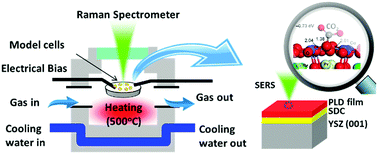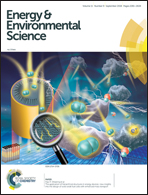A highly active, CO2-tolerant electrode for the oxygen reduction reaction†
Abstract
One challenge facing the development of high-performance cathodes for solid oxide fuel cells (SOFC) is the fast degradation rate of cathodes due to poisoning by contaminants commonly encountered in ambient air such as CO2. Here we report a double perovskite PrBa0.8Ca0.2Co2O5+δ (PBCC) cathode with excellent ORR activity and remarkable CO2 tolerance under realistic operation conditions. When tested in a symmetrical cell in air with ∼1 vol% CO2 at 750 °C, the PBCC electrode shows an area specific resistance of ∼0.024 Ω cm2, which increases to 0.028 Ω cm2 after 1000 h operation. The degradation rate is ∼1/24 of that of the state-of-the-art La0.6Sr0.4Co0.2Fe0.8O3 (LSCF) cathode under the same conditions. Impedance spectroscopy and in situ surface enhanced Raman spectroscopy analyses indicate that the surface of the PBCC electrode is much more active for oxygen exchange and more robust against CO2 than that of LSCF, as confirmed by density functional theory calculations. The fast ORR kinetics and excellent durability of PBCC in air with CO2 highlight the potential of PBCC as a highly promising material for devices involving oxygen electrochemistry such as solid oxide fuel cells, electrolysis cells, or gas separation membranes.



 Please wait while we load your content...
Please wait while we load your content...
